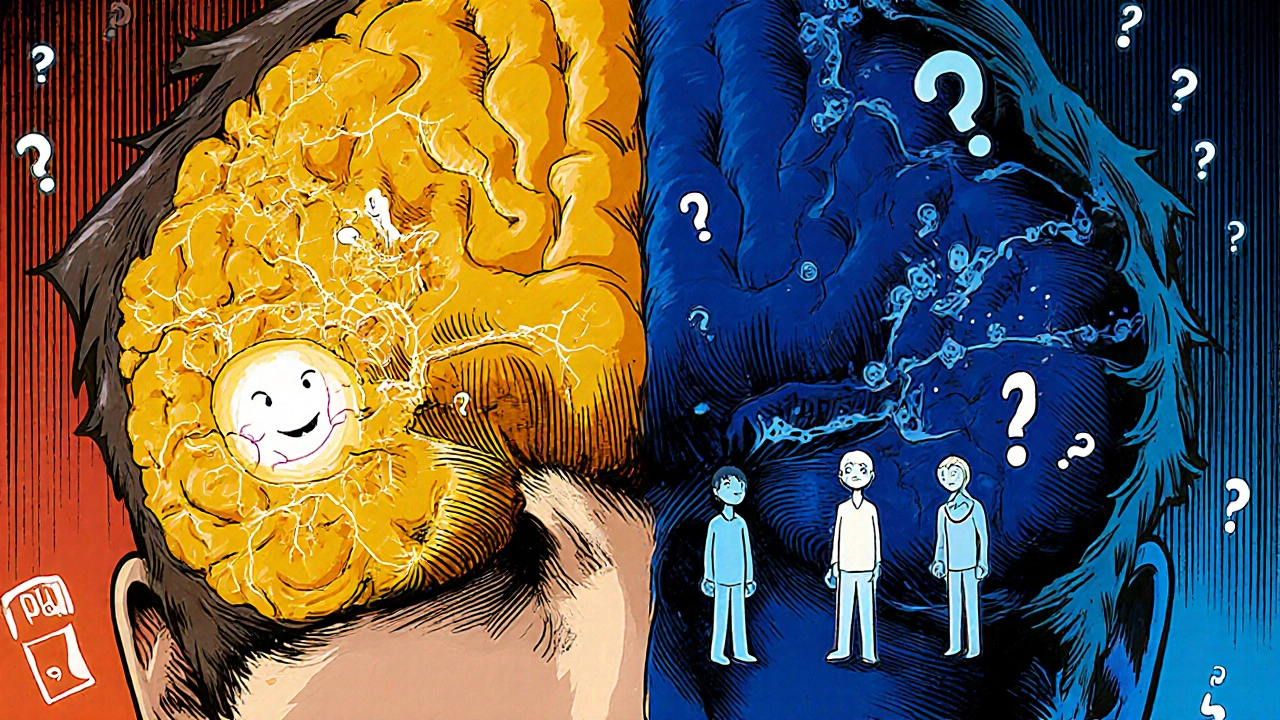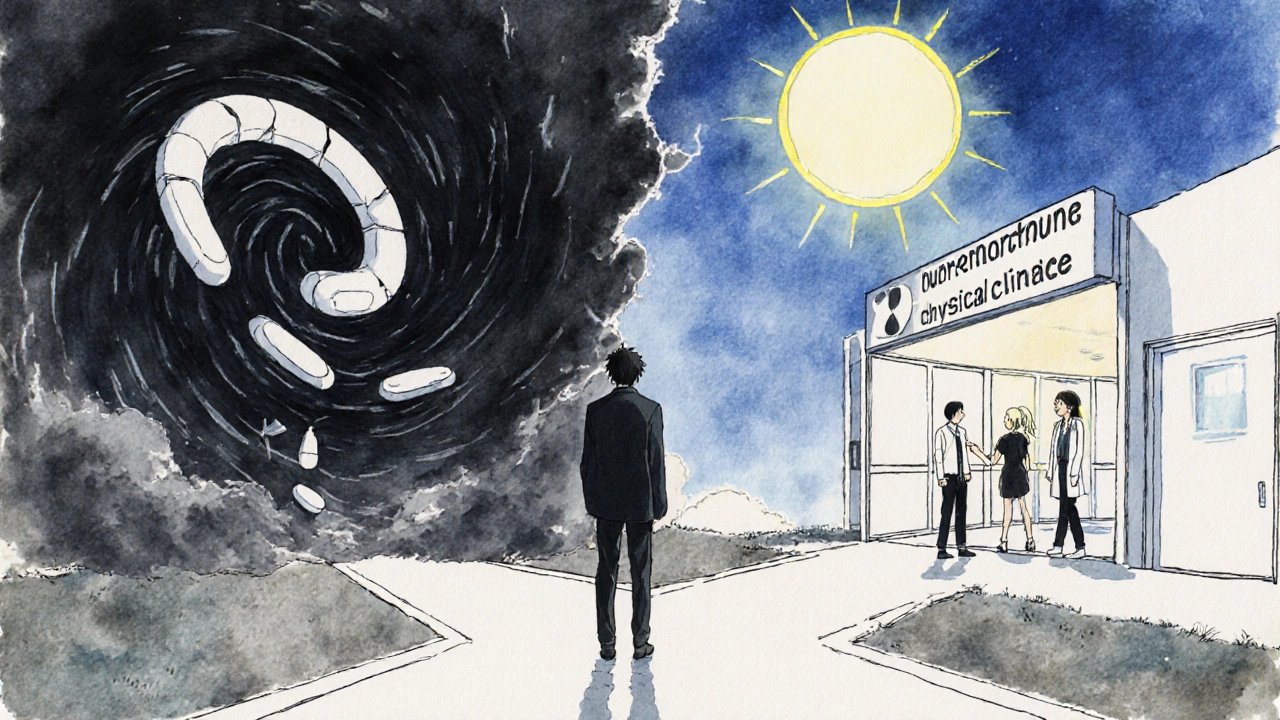PHQ-9 Depression Screening Tool
Depression Screening
This is a 9-question assessment to measure your depression symptoms over the past 2 weeks. It's a standard tool used by healthcare providers to screen for depression.
When someone starts taking opioids for chronic pain, they often expect relief from physical discomfort. What they don’t always expect is a slow, quiet shift in how they feel emotionally - a loss of interest in things they used to enjoy, constant fatigue, or feeling numb even when the pain is under control. This isn’t just bad luck. Opioids and depression are deeply linked, and the connection isn’t simple. It’s not just that people with depression take more opioids - it’s that opioids can actually make depression worse over time. And if you’re already depressed, opioids can trap you in a cycle that’s hard to break.
Why Opioids Can Make Depression Worse
Opioids work by binding to receptors in your brain that control pain, but those same receptors are also part of your brain’s natural mood system. In the short term, this can feel like a lift - pain fades, and so does the emotional weight that comes with it. That’s why some people report feeling calmer or even euphoric after their first dose.
But here’s the catch: your brain adapts. With daily use, your body starts producing less of its own natural painkillers and mood regulators. Studies show that after weeks or months, the very system meant to help you feel better becomes less responsive. This is called tolerance - and it doesn’t just mean you need higher doses for pain. It also means you need more opioids just to feel normal emotionally.
A 2020 study in JAMA Psychiatry used genetic data from over 300,000 people to show that people with a higher genetic risk for using prescription opioids were also more likely to develop major depression. This wasn’t just correlation - it suggested opioids themselves might be driving the rise in depression, not just being taken by people who were already depressed.
The numbers are startling. Between 12.9% and 32% of people on long-term opioid therapy report symptoms of depression. In some groups, like patients recovering from serious injuries, that number jumps to over 50%. And here’s the most concerning part: doctors miss nearly half of these cases. If you’re seeing your doctor for back pain and they don’t ask how you’re feeling emotionally, you might be slipping into depression without anyone noticing.
The Vicious Cycle: Depression Fuels Opioid Use
It’s not just opioids causing depression - depression makes you more likely to rely on opioids. People with depression often experience physical pain more intensely. They’re more sensitive to discomfort, and they have a harder time coping with it. That means they’re more likely to ask for stronger pain meds, take them more often, and stay on them longer.
Research shows that people with depression are twice as likely to move from short-term opioid use to long-term dependence. They also tend to get higher doses. One study found that people with depression were 2.65 times more likely to be prescribed more than 50 mg of morphine equivalent per day - a dose that significantly raises the risk of depression worsening.
This creates a loop: pain leads to opioids → opioids worsen mood → worse mood leads to more opioid use → mood gets worse again. It’s not just about addiction - it’s about your brain getting stuck in a pattern where both pain and sadness feed off each other.
What Does Opioid-Induced Depression Look Like?
Opioid-related depression doesn’t always look like classic sadness. You might not cry all the time. Instead, you might notice:
- Loss of interest in hobbies, friends, or even sex - things that used to matter don’t feel worth doing anymore
- Feeling emotionally flat or numb, even when good things happen
- Constant tiredness, even after sleeping
- Difficulty concentrating or making simple decisions
- Sleeping too much or not being able to sleep at all
- Thoughts like “What’s the point?” or “I’m just a burden”
These symptoms often show up slowly. You might think, “I’m just tired from the pain,” or “I guess this is what life is like now.” But if you’ve been on opioids for more than a few months and you’re noticing these changes, it’s not normal. It’s a sign your brain is struggling.

How to Monitor Your Mood While on Opioids
Monitoring your mood isn’t optional - it’s as important as checking your blood pressure or pain levels. The American Pain Society and CDC both recommend regular screening for depression in anyone on long-term opioids. But in practice, most doctors don’t do it consistently. Don’t wait for your doctor to ask - take charge.
Start with the PHQ-9, a simple 9-question tool used in clinics worldwide. You can find it online for free. Answer honestly:
- Little interest or pleasure in doing things
- Feeling down, depressed, or hopeless
- Trouble falling or staying asleep
- Feeling tired or having little energy
- Poor appetite or overeating
- Feeling bad about yourself
- Trouble concentrating
- Moving or speaking so slowly that others notice
- Thoughts that you’d be better off dead
Score each from 0 (not at all) to 3 (nearly every day). A total of 10 or higher suggests moderate to severe depression. Do this every three months - or every month if you’re on high doses or have a history of depression.
Also, keep a simple mood journal. Write down one sentence each day: “Today, I felt…”. After a few weeks, look back. Are you writing “numb” or “empty” more than “okay” or “hopeful”? That’s your brain telling you something’s off.
Buprenorphine: A Glitch in the System
There’s one opioid that seems to break the pattern: buprenorphine. Unlike morphine or oxycodone, it doesn’t fully activate the brain’s opioid receptors. Instead, it gives just enough stimulation to ease pain and cravings without the same crash afterward.
In Australia, the POATS trial found that people with opioid use disorder who were treated with buprenorphine saw their depression scores drop by almost half over three months. In another study, patients with treatment-resistant depression who took low-dose buprenorphine (1-2 mg/day) saw improvements in mood within a week.
But here’s the problem: the FDA hasn’t approved buprenorphine for treating depression. That means most doctors can’t legally prescribe it for that purpose - even if it helps. In Australia, some pain specialists do use it off-label for patients with both chronic pain and depression, but access is uneven.
If you’re on buprenorphine and your mood improves, don’t assume it’s just because your pain is better. It might be the drug itself lifting your mood. Talk to your doctor about whether this could be part of your long-term plan.

What to Do If You’re Struggling
If you notice mood changes while on opioids, don’t wait. Don’t think, “I’ll just tough it out.” Don’t assume your doctor will notice. Here’s what to do:
- Take the PHQ-9 and bring the results to your next appointment
- Ask: “Could my mood changes be linked to my opioid use?”
- Request a referral to a pain psychologist or psychiatrist who understands opioid-related mental health issues
- Ask about non-opioid pain options - physical therapy, nerve blocks, or even certain antidepressants like duloxetine that also help with chronic pain
- If you’re on high doses (>50 mg MED), ask if tapering could help your mood - even if your pain doesn’t fully go away
One study found that when depression was treated with cognitive behavioral therapy alongside pain management, patients reduced their opioid use by 32%. That’s not just a side effect - it’s a win.
The Bigger Picture: Why This Matters
This isn’t just about one person feeling down. It’s about a system that treats pain without looking at the whole person. We’ve spent decades focusing on whether opioids work for pain. Now we’re learning they can break something else - your emotional resilience.
Researchers are now using brain scans to see how long-term opioid use changes the structure and function of mood centers in the brain. Early results suggest the brain’s reward system gets rewired, making natural sources of joy - like spending time with loved ones or enjoying a walk - feel less satisfying.
The good news? You’re not powerless. If you’re on opioids and feeling off emotionally, it’s not your fault. It’s a known biological effect. And there are ways out - but they start with noticing the change, speaking up, and asking for help.
Can opioids cause depression even if I’m not addicted?
Yes. You don’t need to be addicted to experience opioid-induced depression. Even people taking opioids as prescribed for chronic pain can develop depressive symptoms. The risk increases with longer use and higher doses - not with misuse. It’s a pharmacological effect, not a sign of weakness or lack of willpower.
How long does it take for opioids to affect my mood?
Mood changes can start as early as 4 to 6 weeks after beginning daily opioid use. Many people notice emotional numbness or loss of interest before they realize it’s linked to their medication. By 3 months, about 27% of long-term users show clear signs of worsening depression, according to clinical studies.
Should I stop taking opioids if I feel depressed?
Don’t stop suddenly. Abruptly stopping opioids can cause severe withdrawal, which can worsen depression. Instead, talk to your doctor about a safe tapering plan. Often, reducing the dose slowly - while adding non-opioid pain treatments and mental health support - leads to better mood and less pain over time.
Are antidepressants safe to take with opioids?
Some are, but not all. SSRIs like sertraline or escitalopram are generally safe and often help with both depression and chronic pain. Avoid certain antidepressants like tricyclics if you’re on high-dose opioids - they can increase the risk of heart rhythm problems. Always check with your doctor or pharmacist before combining medications.
Is there a test to know if opioids are causing my depression?
There’s no single blood test or scan that confirms it. But if your depression started after beginning opioids, got worse as your dose increased, and improved when your dose was lowered - that’s strong clinical evidence. Tracking your mood with tools like the PHQ-9 over time gives your doctor the data they need to make the connection.
Next Steps: What You Can Do Today
If you’re on opioids and unsure about your mood:
- Download the PHQ-9 questionnaire and complete it today
- Write down three recent changes in how you feel emotionally
- Call your doctor and say: “I’ve noticed I’m feeling more flat or hopeless lately. Could this be related to my opioids?”
- Ask if you can be referred to a pain specialist or psychiatrist who understands opioid-related depression
You’re not alone. Thousands of people are walking this path - and many have found relief by addressing both pain and mood together. The goal isn’t to stop opioids overnight. It’s to break the cycle before it breaks you.


Author
Mike Clayton
As a pharmaceutical expert, I am passionate about researching and developing new medications to improve people's lives. With my extensive knowledge in the field, I enjoy writing articles and sharing insights on various diseases and their treatments. My goal is to educate the public on the importance of understanding the medications they take and how they can contribute to their overall well-being. I am constantly striving to stay up-to-date with the latest advancements in pharmaceuticals and share that knowledge with others. Through my writing, I hope to bridge the gap between science and the general public, making complex topics more accessible and easy to understand.